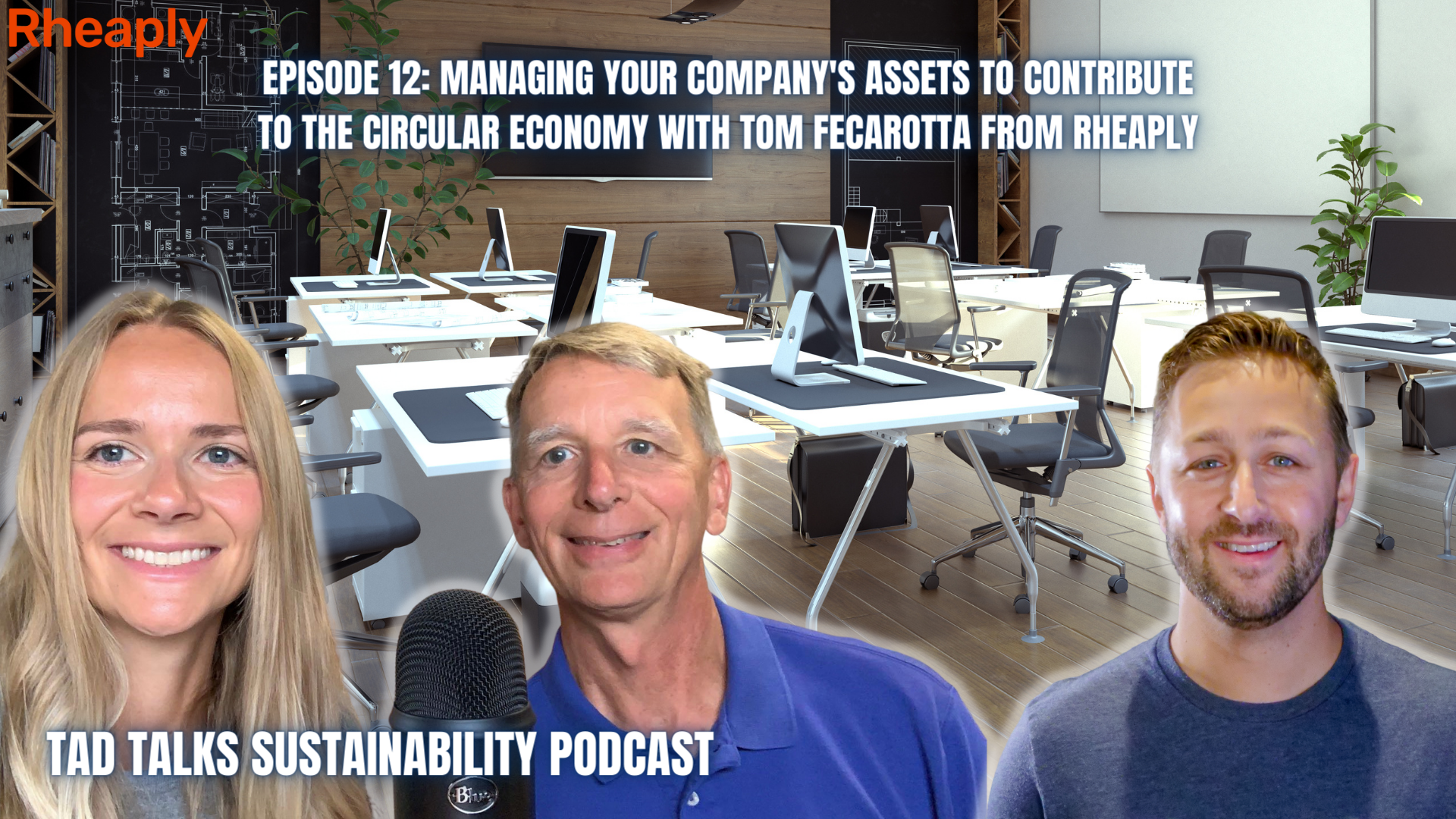Episode 12: Managing Your Company’s Assets to Contribute to the Circular Economy with Tom Fecarotta from Rheaply
Click the links below to listen to the full episode
Most companies have various assets that need to be managed regularly, and proper management of these materials can actually contribute to the circular economy. In this episode, Tad and Julianna sit down with Tom Fecarotta, Chief Marketing Officer at Rheaply, to discuss Rheaply’s approach to asset management and Total Resource Efficiency, documenting and measuring the embodied carbon savings from material reuse, how material reuse contributes to the circular economy, and how to get started with Rheaply’s platform.
We know your focus is on Total Resource Efficiency, can you explain what that means and how it contributes to the circular economy?
“Total resource efficiency to us is really the focus on how do you catalog assets? How do you identify assets within an organization that have usability or utility? Then how do you measure the whereabouts of the dynamic state of that asset, as it moves into different locations. For us that means transparency within the supply chain. How do we use our technology, which is meant to be inclusive, so anyone within an organization if they're permitted to, has visibility into these assets and can claim those assets or request an asset. It becomes this sort of holistic, unified way of sharing. Whether that's during upstream procurement for something I need for my office or workspace, or downstream where I need to find to a reuse retailer, disposition partner, or a remanufacturer. We want to make sure that that visibility is made public, if permitted.”
We understand you are working to measure and document the embodied carbon savings from material reuse and resource efficiency, can you tell us more about that?
“Measurement is key. We can't have really any zero waste goals, or any carbon reduction goals without measurement. Our approach is, how do we look at scope three emissions especially? We can dive into how behind we are on that, but we need CO2 data calculated in order to hold ourselves accountable. So we are trying to support that for our organizations. A lot of sustainability focused higher-ed professionals and local government professionals need that CO2 data calculated from embodied carbon of reuse to monitor and report their greenhouse gas emissions. The way we're thinking about this really is built around this idea of if you have an asset and you understand the full manufacturing efforts that went into the production of that asset, you could calculate the indirect emissions behind that asset.
There's a couple organizations out there, specifically EC3 and the Embodied Carbon in Construction Calculator, that looks at all of the inputs into a product during the manufacturing process. If you can capture that data for people, we help them visualize when they’re posting something for reuse, or maybe for recirculation, what that means from a CO2 equivalency perspective. We actually show you that by just the act of reuse, or the act of extending the life of one item, you're pulling quite a bit of carbon out of it. Then if you do it a second time, that's a multiplier. If you had a window into our technology right now, we've got a waste diversion aspect just in weight where we show how much weight was diverted from the landfill. We've got a cost savings aspect where we show the cost savings reduction by not having to procure something twice. Then what we're going to have is this kind of third aspect around the CO2 equivalency of that decision. Then we aggregate that data and help organizations better understand the impact of supply chain efficiency and circularity.”
We work with a lot of different organizations, if someone is interested in utilizing your platform, what are the next steps for them to get started?
“A conversation. On our website you can register your interests to help us better understand the issues in scaling circularity and scaling reuse of your assets. We have organizations with many different inventory issues in both demand surplus. It's hard to understand the demand of items that, at a surface level, have no utility. Or maybe the person making the disposition decision doesn't fully understand the value of something, or they've run out of time and they have to clear out a space. The ladder is a problem that is actually something we're trying to solve every day, especially in the built environment. So naturally we want to build these sort of network hubs, and having a conversation around the categories of assets that you're trying to recirculate is really important. For biopharma, where we got our roots, maybe that's tracking and sharing lab consumables and reagents and things of that nature. Enterprise facilities and architectural firms are trying to find building products and salvage these historically important resources from going to waste. We can help you catalog those assets and help you become more efficient in the operational workflows that are in place for reuse efforts.
When we look at an organization and think about partnerships, we're inventory and asset agnostic. We don't care if you're trying to recirculate ping pong tables, antibodies, furniture, or desks and chairs. We take a look and help you determine what assets need to be recirculated in a more efficient manner and how can we digitize that together. So I'd say the first step is registering your interest in digitizing some of these efforts and making sure that we're cataloging your inventory in a way that is reflective of your operational workflow.
ABOUT Tom Fecarotta
Tom Fecarotta is the Chief Marketing Officer for Rheaply, an award-winning technology to scale reuse and the circular economy for world-leading organizations. Tom’s leadership responsibilities include managing Rheaply's RevOps marketing & demand gen strategy, event strategy, client relations, and Rheaply's partner marketing program. Prior to joining Rheaply, Tom worked for 10+ years as a content and event marketer for various life science brands & technologies, developing event campaigns and launch strategies for leading biotech/biopharma and healthcare organizations.






